Corrosion Behavior of Ferritic 12Cr ODS and Martensitic X46Cr13 Steels in Nitric Acid and Sodium Chloride Solutions
Abstract
1. Introduction
2. Materials and Methods
2.1. Materials
2.1.1. 12Cr RAF ODS Steel
2.1.2. X46Cr13 Martensitic Stainless Steel
2.2. Immersion Test
2.3. Potentiodynamic Polarization Test
2.4. Microstructure and Phase Composition
3. Results
3.1. Immersion Test in Boiling 0.1–14 M HNO3
3.2. Potentiodynamic Polarization Test in 1 M and 4 M HNO3
3.3. Potentiodynamic Polarization Test in 0.61 M NaCl
4. Conclusions
Author Contributions
Funding
Institutional Review Board Statement
Informed Consent Statement
Data Availability Statement
Conflicts of Interest
References
- Hu, Z.; Qi, L. Treatise on Geochemistry, 2nd ed.; Holland, H.D., Turekian, K.K., Eds.; Elsevier Science: Oxford, UK, 2014; Volume 15, pp. 87–109. [Google Scholar]
- Iversen, A.; Leffler, B. Shreir’s Corrosion, 4th ed.; Cottis, B., Graham, M., Lindsay, R., Lyon, S., Richardson, T., Scantlebury, D., Stott, H., Eds.; Elsevier Science: Oxford, UK, 2010; Volume 3, pp. 1802–1878. [Google Scholar]
- Kato, C. Comprehensive Nuclear Materials, 2nd ed.; Konings, R.J.M., Stoller, R.E., Eds.; Elsevier: Oxford, UK, 2020; Volume 4, pp. 528–563. [Google Scholar]
- Xu, J.; Liu, C.; Li, H.; Wu, W.; Wu, J.; Zhao, B.; Zhang, Y.; Zhao, Y.; Zhou, L. Orientation dependence of corrosion resistance of a near–alpha Ti35 alloy applied in nuclear industry. J. Nucl. Mater. 2022, 568, 153873. [Google Scholar] [CrossRef]
- Ewing, R.C. Long–term storage of spent nuclear fuel. Nat. Mater. 2015, 14, 252–257. [Google Scholar] [CrossRef] [PubMed]
- Herbst, R.S.; Baron, P.; Nilsson, M. Advanced Separation Techniques for Nuclear Fuel Reprocessing and Radioactive Waste Treatment; Nash, K.L., Lumetta, G.J., Eds.; Woodhead Publishing: Cambridge, UK, 2011; pp. 141–175. [Google Scholar]
- Birkett, J.E.; Carrott, M.J.; Fox, O.D.; Jones, C.J.; Maher, C.J.; Roube, C.V.; Taylor, R.J.; Woodhead, D.A. Recent Developments in the Purex Process for Nuclear Fuel Reprocessing: Complexant Based Stripping for Uranium/Plutonium Separation. CHIMIA 2005, 59, 898–904. [Google Scholar] [CrossRef]
- Raj, B.; Mudali, U.K. Materials development and corrosion problems in nuclear fuel reprocessing plants. Prog. Nucl. Energy 2006, 48, 283–313. [Google Scholar] [CrossRef]
- Nagano, H.; Kajimura, H. The stress corrosion cracking performance of pure zirconium and zirconium alloys in highly oxidizing nitric acid. Corros. Sci. 1996, 38, 781–791. [Google Scholar] [CrossRef]
- Nowik, K.; Zybała, R.; Oksiuta, Z. Formation and Microstructural Evolution of Ferritic ODS Steel Powders during Mechanical Alloying. Materials 2023, 16, 765. [Google Scholar] [CrossRef] [PubMed]
- Wang, J.; Long, D.; Yu, L.; Liu, Y.; Li, H.; Wang, Z. Influence of Al addition on the microstructure and mechanical properties of Zr-containing 9Cr-ODS steel. J. Mater. Res. Technol. 2021, 13, 1698–1708. [Google Scholar] [CrossRef]
- Odette, G.R.; Alinger, M.J.; Wirth, B.D. Recent Developments in Irradiation-Resistant Steels. Annu. Rev. Mater. Res. 2008, 38, 471–503. [Google Scholar] [CrossRef]
- Tanno, T.; Takeuchi, M.; Ohtsuka, S.; Kaito, T. Corrosion behavior of ODS steels with several chromium contents in hot nitric acid solutions. J. Nucl. Mater. 2017, 494, 219–226. [Google Scholar] [CrossRef]
- Jian, L.; Jian, P.; Bing, H.; Xie, G. Oxidation kinetics of Haynes 230 alloy in air at temperatures between 650 and 850 °C. J. Power Sources 2006, 159, 641–645. [Google Scholar] [CrossRef]
- Dheeradhada, V.S.; Cao, H.; Alinger, M.J. Oxidation of ferritic stainless steel interconnects: Thermodynamic and kinetic assessment. J. Power Sources 2011, 196, 1975–1982. [Google Scholar] [CrossRef]
- Rosemann, P.; Müller, T.; Babutzka, M.; Heyn, A. Influence of microstructure and surface treatment on the corrosion resistance of martensitic stainless steels 1.4116, 1.4034, and 1.4021. Mater. Corros. 2015, 66, 45–53. [Google Scholar] [CrossRef]
- Kubaschewski, O.; Hopkins, B.E. Oxidation of Metals and Alloys; Butterworths Scientific Publications: London, UK, 1953. [Google Scholar]
- Pietrzak, K.; Sobczak, N.; Chmielewski, M.; Homa, M.; Gazda, A.; Zybała, R.; Strojny–Nędza, A. Effects of Carbon Allotropic Forms on Microstructure and Thermal Properties of Cu-C Composites Produced by SPS. J. Mater. Eng. Perform. 2016, 25, 3077–3083. [Google Scholar] [CrossRef][Green Version]
- Brnic, J.; Krscanski, S.; Lanc, D.; Brcic, M.; Turkalj, G.; Canadija, M.; Niu, J. Analysis of the Mechanical Behavior, Creep Resistance and Uniaxial Fatigue Strength of Martensitic Steel X46Cr13. Materials 2017, 10, 388. [Google Scholar] [CrossRef] [PubMed]
- Rosemann, P.; Kauss, N.; Müller, C.; Halle, T. Influence of solution annealing temperature and cooling medium on microstructure, hardness and corrosion resistance of martensitic stainless steel X46Cr13. Mater. Corros. 2015, 66, 1068–1076. [Google Scholar] [CrossRef]
- ASTM G31-21a; Standard Guide for Laboratory Immersion Corrosion Testing of Metals. ASTM International: West Conshohocken, PA, USA, 2012; pp. 1–10. [CrossRef]
- Malaret, F. Exact calculation of corrosion rates by the weight–loss method. Exp. Results 2022, 3, 1–12. [Google Scholar] [CrossRef]
- ASTM G44-21; Standard Practice for Exposure of Metals and Alloys by Alternate Immersion in Neutral 3.5% Sodium Chloride Solution. ASTM International: West Conshohocken, PA, USA, 2021; pp. 1–4. [CrossRef]
- Bard, A.J.; Faulkner, L.R. Electrochemical Methods–Fundamentals and Applications, 2nd ed.; Wiley: New York, NY, USA, 2001; pp. 91–107. [Google Scholar]
- Stern, M.; Geary, A.L. Electrochemical polarization: I. A theoretical analysis of the shape of polarization curves. J. Electrochem. Soc. 1957, 104, 56–63. [Google Scholar] [CrossRef]
- Matthews, D.B. The Stern–Geary and related methods for determining corrosion rates. Aust. J. Chem. 1975, 28, 243–251. [Google Scholar] [CrossRef]
- Hiromoto, S. Metals for Biomedical Devices; Niinomi, M., Ed.; Woodhead Publishing Limited: Cambridge, UK, 2010; Chapter 4; pp. 99–121. [Google Scholar]
- Rocchini, G. The determination of Tafel slopes by the successive approximation method. Corros. Sci. 1995, 37, 987–1003. [Google Scholar] [CrossRef]
- Scardi, P.; Leoni, M. Whole powder pattern modelling. Acta Crystallogr. A 2002, 58, 190–200. [Google Scholar] [CrossRef]
- Bowman, A.L.; Arnold, G.P.; Storms, E.K.; Nereson, N.G. The crystal structure of Cr23C6. Acta Crystallogr. B 1972, 28, 3102–3103. [Google Scholar] [CrossRef]
- Baltušnikas, A.; Grybėnas, A.; Kriūkienė, R.; Lukošiūtė, I.; Makarevičius, V. Evolution of Crystallographic Structure of M23C6 Carbide Under Thermal Aging of P91 Steel. J. Mater. Eng. Perform. 2019, 28, 1480–1490. [Google Scholar] [CrossRef]
- Kim, J.S. Effect of alloying elements on the contact resistance and the passivation behaviour of stainless steels. Corros. Sci. 2002, 44, 635–655. [Google Scholar] [CrossRef]
- Ningshen, S.; Sakairi, M.; Suzuki, K.; Ukai, S. Corrosion resistance of 9–15% Cr ODS steels and its comparison with austenitic stainless steel. Adv. Mater. Res. 2013, 794, 575–582. [Google Scholar] [CrossRef]
- Ningshen, S.; Sakairi, M.; Suzuki, K.; Ukai, S. The surface characterization and corrosion resistance of 11% Cr ferritic/martensitic and 9–15% Cr ODS steels for nuclear fuel reprocessing application. J. Solid State Electrochem. 2014, 18, 411–425. [Google Scholar] [CrossRef]
- Nagini, M.; Jyothirmayi, A.; Vijay, R.; Rao, T.N.; Reddy, A.V.; Rajulapati, K.V.; Sundararajan, G. Influence of dispersoids on corrosion behavior of oxide dispersion strengthened 18Cr steels made by high energy milling. J. Mater. Eng. Perform. 2016, 25, 577–586. [Google Scholar] [CrossRef]
- Truman, J.E. Corrosion Resistance of 13% Chromium Steels as Influenced by Tempering Treatments. Br. Corros. J. 1976, 11, 92–96. [Google Scholar] [CrossRef]
- Candelária, A.F.; Pinedo, C.E. Influence of the heat treatment on the corrosion resistance of the martensitic stainless steel type AISI 420. J. Mater. Sci. Lett. 2003, 22, 1151–1153. [Google Scholar] [CrossRef]
- Hidalgo, P.J. Pitting corrosion of martensitic cutlery steels. Surf. Technol. 1980, 10, 193–208. [Google Scholar] [CrossRef]
- Nakamichi, H.; Sato, K.; Miyata, Y.; Kimura, M.; Masamura, K. Quantitative analysis of Cr–depleted zone morphology in low carbon martensitic stainless steel using Fe–(S)TEM. Corros. Sci. 2008, 50, 309–315. [Google Scholar] [CrossRef]
- Auger, M.A.; de Castro, V.; Leguey, T.; Muñoz, A.; Pareja, R. Microstructure and mechanical behavior of ODS and non–ODS Fe–14Cr model alloys produced by spark plasma sintering. J. Nucl. Mater. 2013, 436, 68–75. [Google Scholar] [CrossRef]
- Duan, Y.; Liu, W.; Ma, Y.; Cai, Q.; Zhu, W.; Lie, J. Microstructure characterization and tensile properties of hot isostatic pressed China ultrahigh strength steel. J. Mater. Res. Technol. 2020, 9, 15192–15201. [Google Scholar] [CrossRef]
- Gwinner, B.; Auroy, M.; Mas, D.; Saint-Jevin, A.; Pasquier-Tilliette, S. Impact of the use of the ferritic/martensitic ODS steels cladding on the fuel reprocessing PUREX process. J. Nucl. Mater. 2012, 428, 110–116. [Google Scholar] [CrossRef]
- Ningshen, S.; Sakairi, M.; Suzuki, K.; Ukai, S. Corrosion resistance of 9% Cr oxide dispersion strengthened steel in different electrolytic media. Corrosion 2013, 69, 863–874. [Google Scholar] [CrossRef]
- Uhlig, H.H.; O’Connor, T.L. Nature of the Passive Film on Iron in Concentrated Nitric Acid. J. Electrochem. Soc. 1955, 102, 562–572. [Google Scholar] [CrossRef]
- Badet, H.; Poineau, F. Corrosion studies of stainless steel 304 L in nitric acid in the presence of uranyl nitrate: Effect of temperature and nitric acid concentration. SN Appl. Sci. 2020, 2, 459. [Google Scholar] [CrossRef]
- Priya, R.; Ningshen, S.; Sakairi, M.; Ukai, S. Corrosion behaviour of Al-containing high Cr ferritic oxide dispersion strengthened steel in nitric acid environment. J. Nucl. Mater. 2020, 534, 152120. [Google Scholar] [CrossRef]
- Ningshen, S.; Sakairi, M.; Suzuki, K.; Ukai, S. The corrosion resistance and passive film compositions of 12% Cr and 15% Cr oxide dispersion strengthened steels in nitric acid media. Corros. Sci. 2014, 78, 322–334. [Google Scholar] [CrossRef]
- Hultquist, G.; Seo, M.; Leitner, T.; Leygraf, T.; Sato, N. The dissolution behaviour of iron, chromium, molybdenum and copper from pure metals and from ferritic stainless steels. Corros. Sci. 1987, 27, 937–946. [Google Scholar] [CrossRef]
- Chen, L.; Xu, S.; Schroer, C.; Jia, H.; Ruan, Z.; Qin, B.; Zhou, Z.; Long, B. Comparison of Corrosion Behavior of T91, 9Cr and 9CrAl ODS Steels in Liquid Pb. Materials 2023, 16, 2295. [Google Scholar] [CrossRef] [PubMed]
- Qiu, X. Structure, Mechanical Properties, and Corrosion Resistance of the CrCuFeNiMo0.3 High-Entropy Alloy Prepared by Powder Metallurgy. Powder Metall. Met. Ceram. 2022, 60, 662–671. [Google Scholar] [CrossRef]
- Lehockey, E.D.; Palumbo, G.; Lin, P.; Brennenstuhl, A.M. On the relationship between grain boundary character distribution and intergranular corrosion. Scr. Mater. 1997, 36, 1211–1218. [Google Scholar] [CrossRef]
- Zhu, Z.; Tan, J.; Zhang, Z.; Wu, X.; Li, J.; Wang, X.; Han, E.-H.; Ke, W. Corrosion behaviors of ODS-FeCrAl in oxygen-saturated lead-bismuth eutectic at 550 °C: Effects of grain boundaries and minor elements. J. Nucl. Mater. 2023, 587, 154710. [Google Scholar] [CrossRef]
- Cui, Z.; Wang, L.; Zhong, M.; Ge, F.; Gao, H.; Man, C.; Liu, C.; Wang, X. Electrochemical Behavior and Surface Characteristics of Pure Titanium During Corrosion in Simulated Desulfurized Flue Gas Condensates. J. Electrochem. Soc. 2018, 165, C542–C561. [Google Scholar] [CrossRef]
- Sinha, P.K.; Kain, V. Superior Corrosion Resistance of Ti-Al-Zr Alloy in Aggressive Nitric Acid Environments. J. Mater. Eng. Perform. 2020, 29, 8441–8450. [Google Scholar] [CrossRef]
- Whillock, G.O.; Worthington, S.E. Shreir’s Corrosion, 4th ed.; Cottis, B., Graham, M., Lindsay, R., Lyon, S., Richardson, T., Scantlebury, D., Stott, H., Eds.; Elsevier Science: Oxford, UK, 2010; Volume 2, pp. 1250–1269. [Google Scholar]
- Fauvet, P.; Balbaud, F.; Robin, R.; Tran, Q.-T.; Mugnier, A.; Espinoux, D. Corrosion mechanisms of austenitic stainless steels in nitric media used in reprocessing plants. J. Nucl. Mater. 2008, 375, 52–64. [Google Scholar] [CrossRef]
- Carmezim, M.J. Capacitance behaviour of passive films on ferritic and austenitic stainless steel. Corros. Sci. 2005, 47, 581–591. [Google Scholar] [CrossRef]
- Tyurin, A.G. Thermodynamic Assessment of the Effect of Chromium and Molybdenum on the Passivability of Nickel-Base Alloys. Prot. Met. 2003, 39, 568–574. [Google Scholar] [CrossRef]
- Dharmalingam, G.; Prabhukumar, S.; Salunkhe, S. Corrosion and high temperature compressive strength behaviour of 17Cr ferritic ODS steel with addition of aluminium through vacuum hot pressing. Adv. Mater. Process. Technol. 2022, 8, 3105–3126. [Google Scholar] [CrossRef]
- Schmuki, P.; Hildebrand, H.; Friedrich, A.; Virtanen, S. The composition of the boundary region of MnS inclusions in stainless steel and its relevance in triggering pitting corrosion. Corros. Sci. 2005, 47, 1239–1250. [Google Scholar] [CrossRef]
- Strehblow, H.-H. Nucleation and Repassivation of Corrosion Pits for Pitting on Iron and Nickel. Werkst. Korros. 1976, 27, 792–799. [Google Scholar] [CrossRef]
- Frankel, G.S. Pitting Corrosion of Metals: A Review of the Critical Factors. J. Electrochem. Soc. 1998, 145, 2186–2198. [Google Scholar] [CrossRef]
- Yang, L.; Qian, H.; Kuang, W. Corrosion Behaviors of Heat–Resisting Alloys in High Temperature Carbon Dioxide. Materials 2022, 15, 1331. [Google Scholar] [CrossRef] [PubMed]
- Mitchell, T.E.; Voss, D.A.; Butler, E.P. The observation of stress effects during the high temperature oxidation of iron. J. Mater. Sci. 1982, 17, 1825–1833. [Google Scholar] [CrossRef]

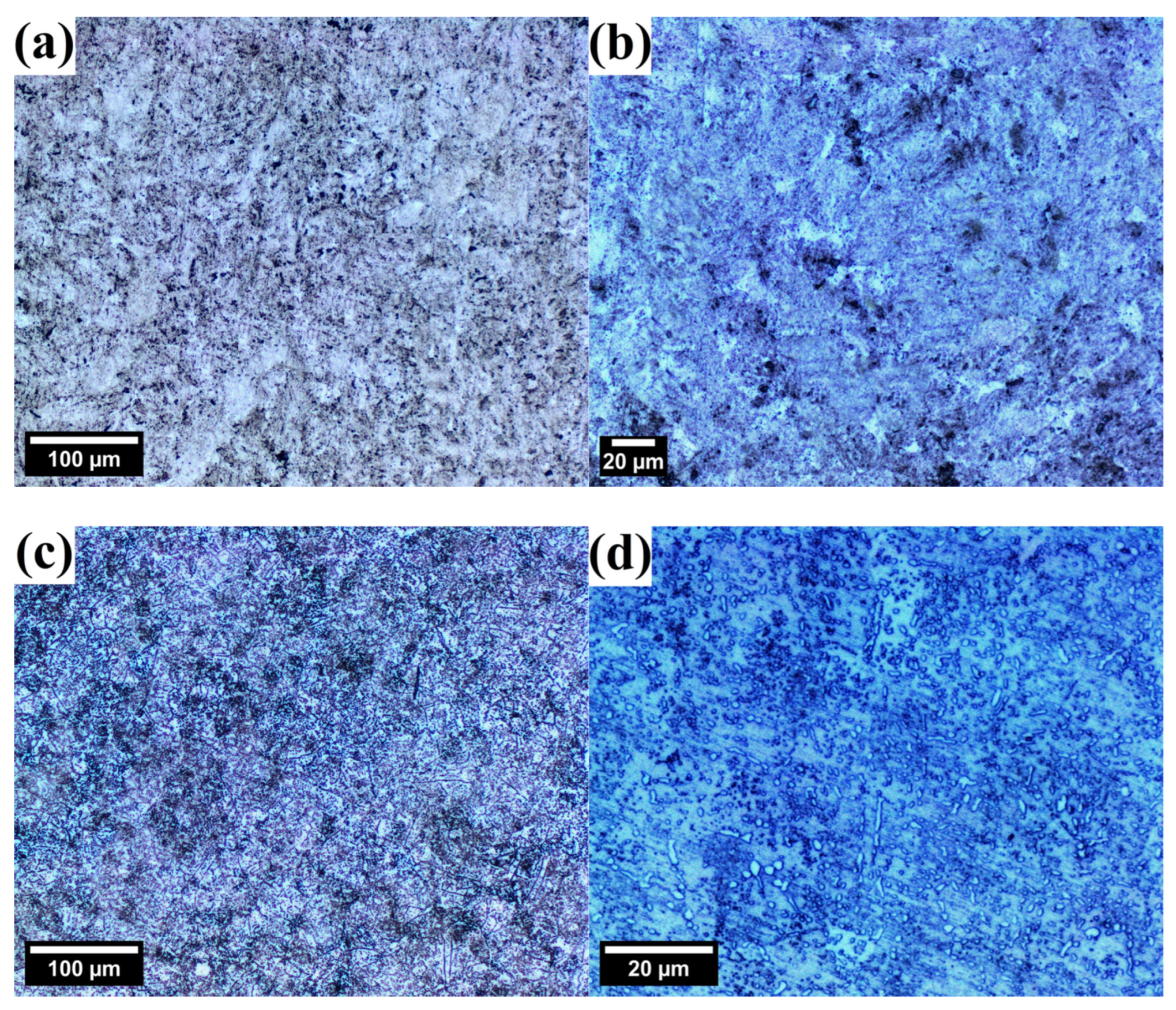
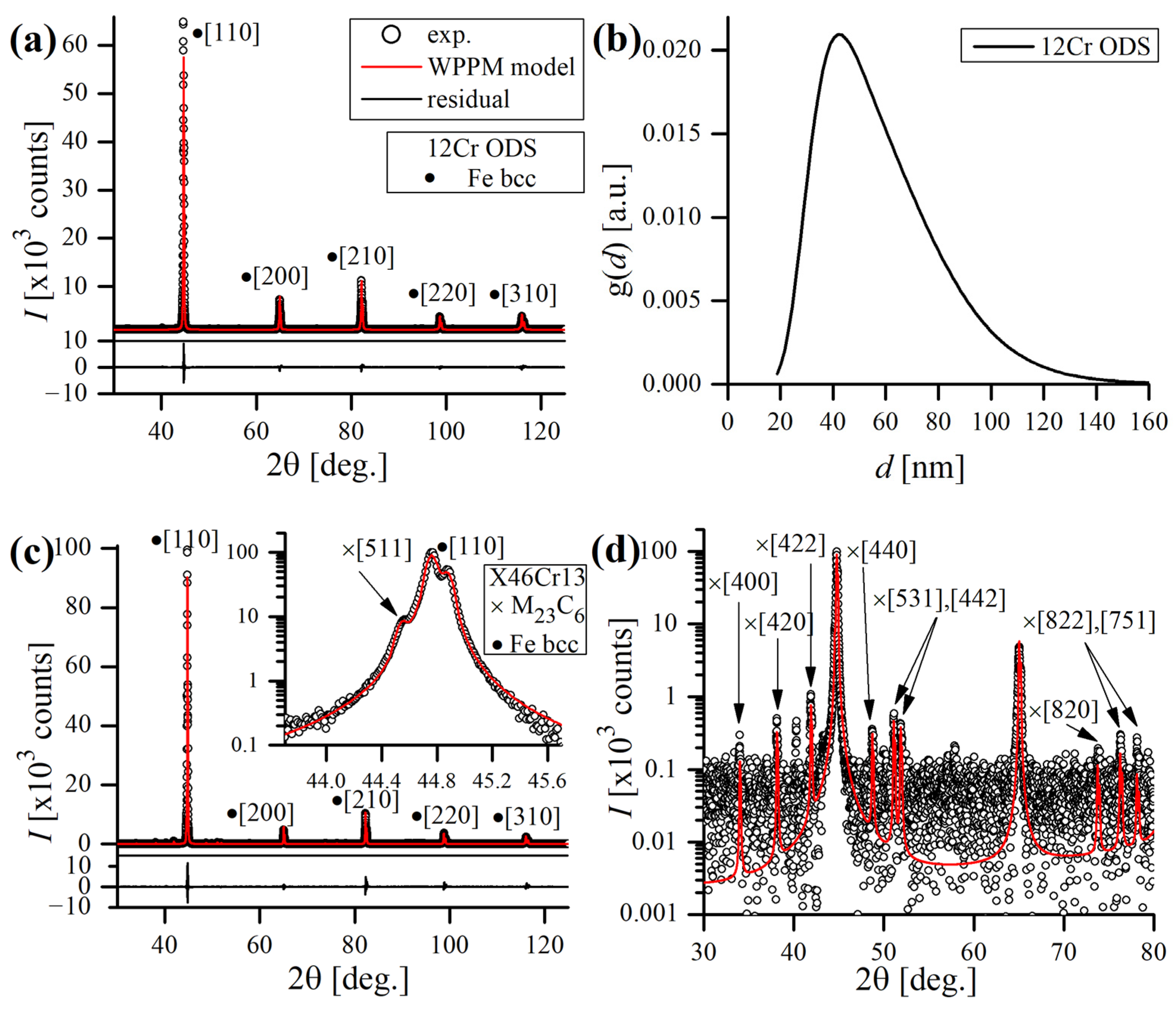
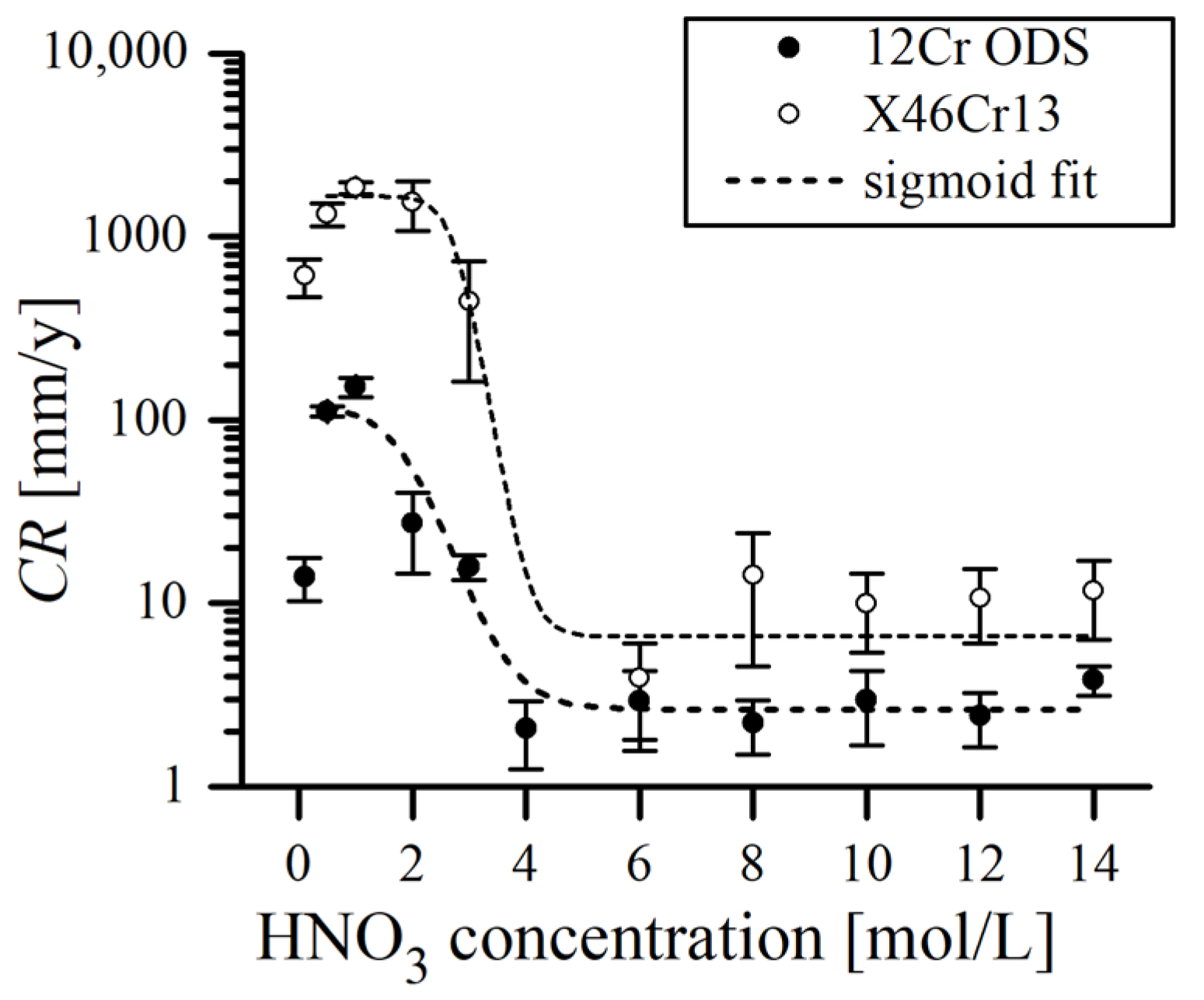
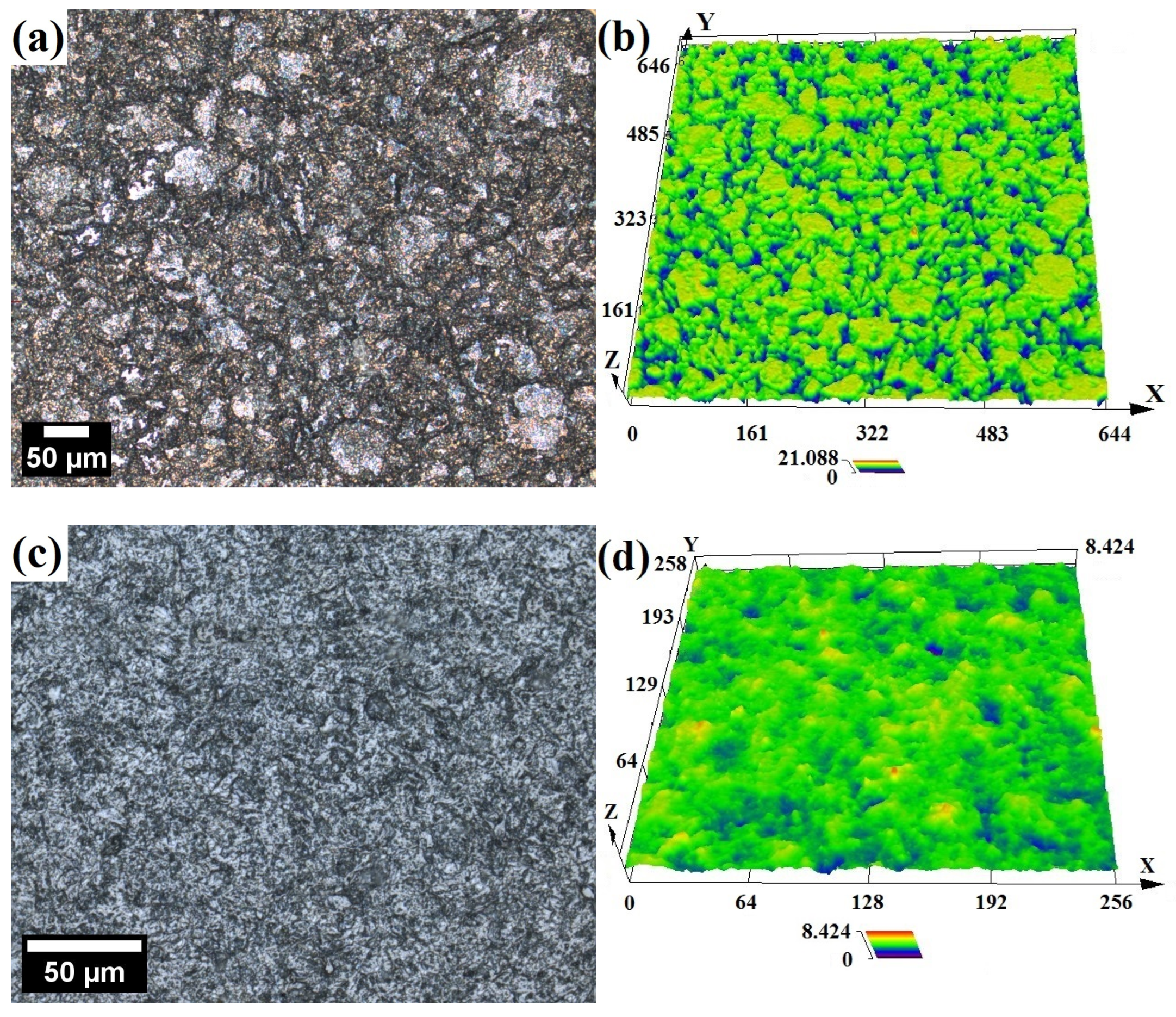
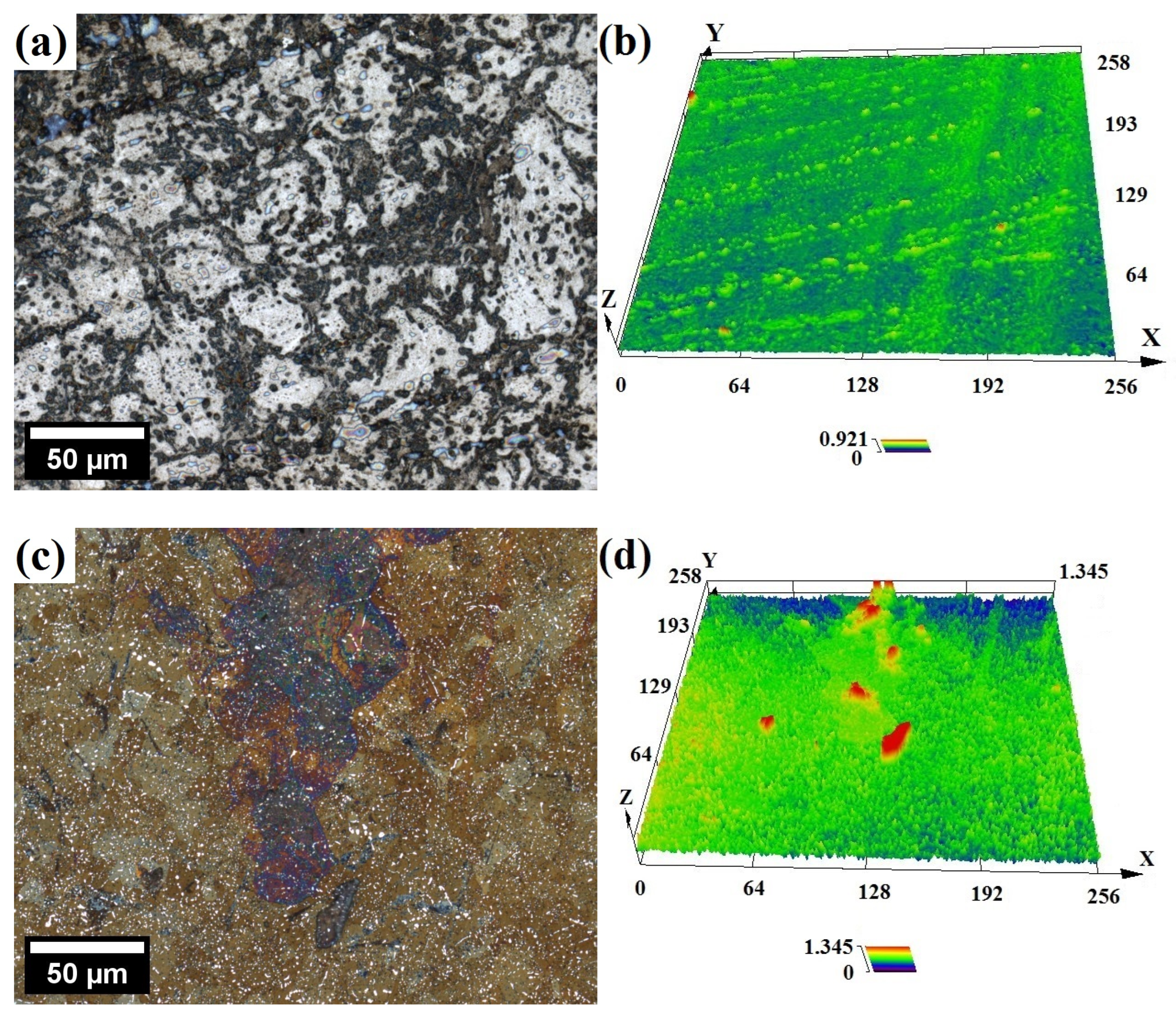

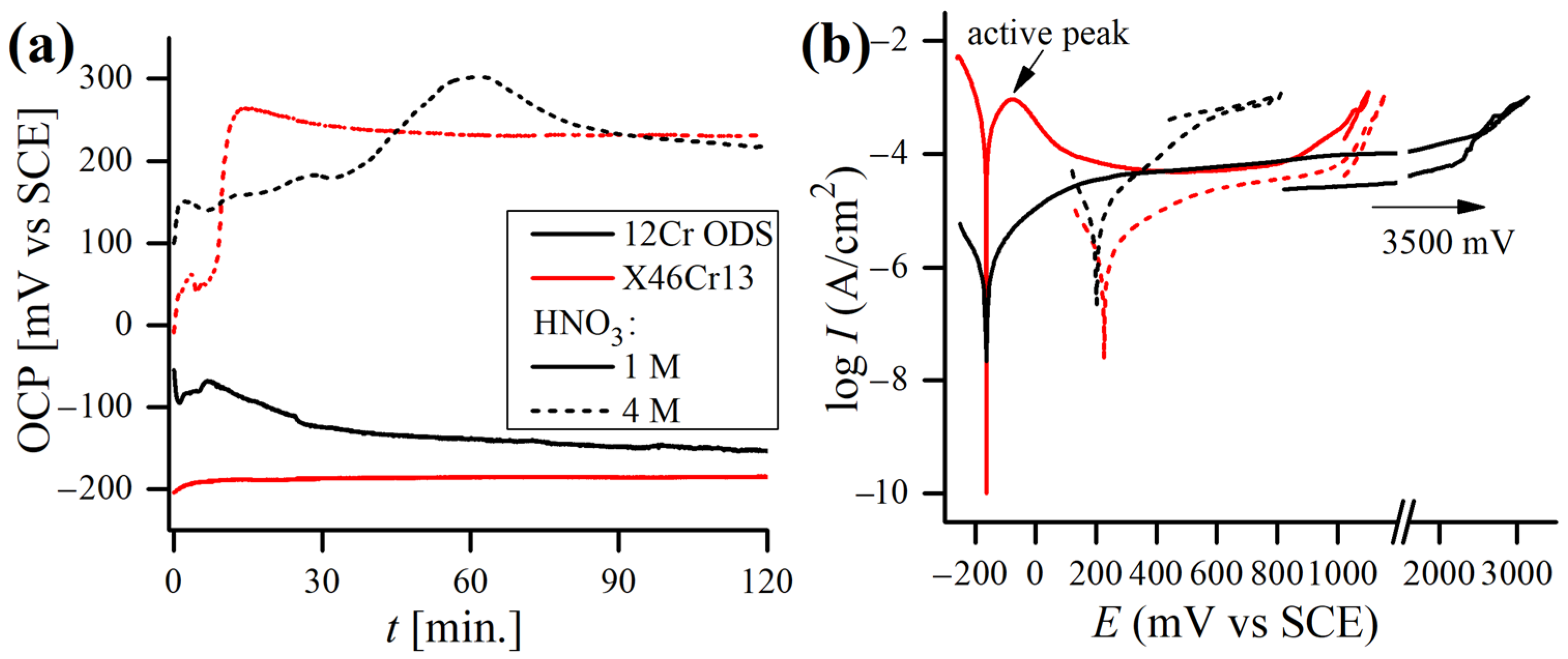
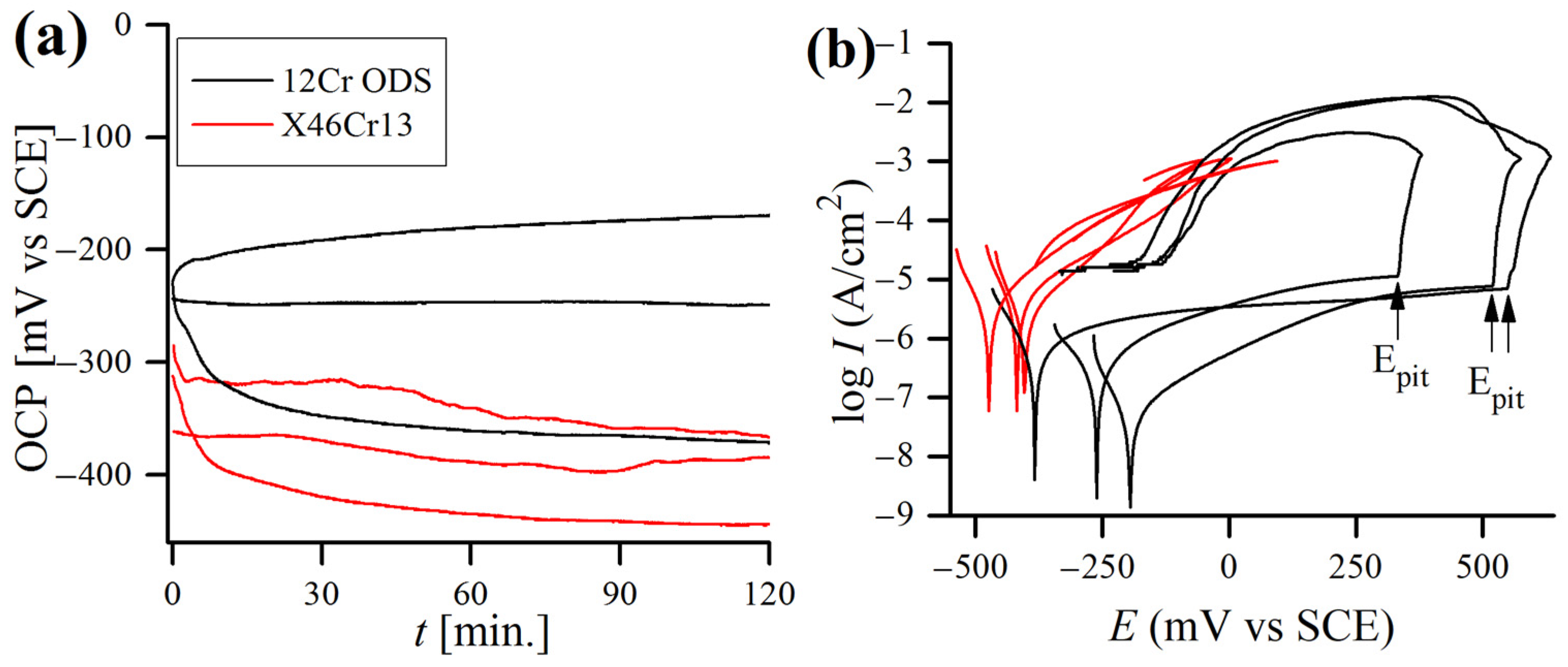
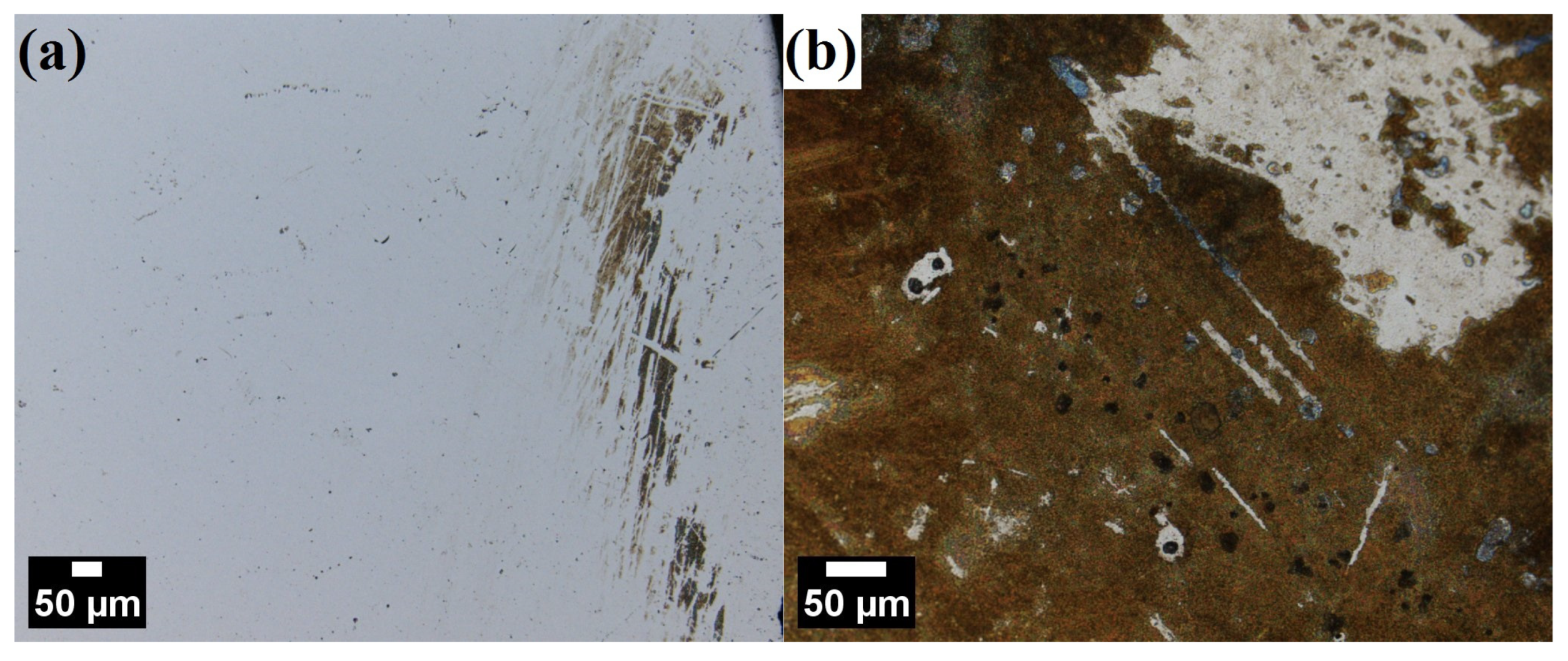


| Alloy | Fe | Cr | W | Zr | C | Si | Mn | Ni |
|---|---|---|---|---|---|---|---|---|
| 12Cr ODS | bal. | 12.58 | 1.49 | 0.57 | 0.11 | 0.02 | 0.10 | - |
| X46Cr13 | bal. | 13.53 | - | 0.01 | 0.46 | 0.29 | 0.54 | 0.19 |
| Material HNO3 Solution | 12Cr ODS 1 M | 12Cr ODS 14 M | X46Cr13 1 M | X46Cr13 14 M |
|---|---|---|---|---|
| [μm] | 1.483 | 0.045 | 0.167 | 0.109 |
| σ [μm] | 0.099 | 0.003 | 0.008 | 0.025 |
| [μm] | 10.698 | 0.427 | 1.222 | 0.757 |
| σ [μm] | 0.798 | 0.035 | 0.120 | 0.131 |
| Material | [mV/SCE] | [kΩcm2] | [mV/dec] | [mV/dec] | [µA/cm2] |
|---|---|---|---|---|---|
| 1 M HNO3, 20 °C | |||||
| 12Cr ODS | −133.0 (42.1) | 17.9 (6.4) | 125.7 (28.7) | 122.5 (20.3) | 1.7 (0.9) |
| X46Cr13 | −171.5 (11.2) | 0.055 (0.0006) | 226.6 (135.8) | 72.6 (21.7) | 429.8 (159.1) |
| 4 M HNO3, 20 °C | |||||
| 12Cr ODS | 201.6 (27.2) | 3.2 (1.1) | 101.7 (18.4) | 86.3 (13.5) | 6.28 (2.22) |
| X46Cr13 | 227.2 (14.9) | 15.7 (4.6) | 175.7 (41.3) | 118.8 (19.6) | 1.96 (1.13) |
| Material | [mV/SCE] | [kΩcm2] | [mV/dec] | [mV/dec] | |
|---|---|---|---|---|---|
| 0.61 M NaCl, 20 °C | |||||
| 12Cr ODS | −392.5 (142.9) | 43.8 (24.4) | 94.3 (26.9) | 81.0 (10.0) | 0.68 (0.48) |
| X46Cr13 | −450.2 (36.2) | 5.0 (1.9) | 73.4 (9.2) | 50.0 (8.3) | 2.89 (1.11) |
Disclaimer/Publisher’s Note: The statements, opinions and data contained in all publications are solely those of the individual author(s) and contributor(s) and not of MDPI and/or the editor(s). MDPI and/or the editor(s) disclaim responsibility for any injury to people or property resulting from any ideas, methods, instructions or products referred to in the content. |
© 2024 by the authors. Licensee MDPI, Basel, Switzerland. This article is an open access article distributed under the terms and conditions of the Creative Commons Attribution (CC BY) license (https://creativecommons.org/licenses/by/4.0/).
Share and Cite
Nowik, K.; Zybała, R.; Sztorch, B.; Oksiuta, Z. Corrosion Behavior of Ferritic 12Cr ODS and Martensitic X46Cr13 Steels in Nitric Acid and Sodium Chloride Solutions. Materials 2024, 17, 3466. https://doi.org/10.3390/ma17143466
Nowik K, Zybała R, Sztorch B, Oksiuta Z. Corrosion Behavior of Ferritic 12Cr ODS and Martensitic X46Cr13 Steels in Nitric Acid and Sodium Chloride Solutions. Materials. 2024; 17(14):3466. https://doi.org/10.3390/ma17143466
Chicago/Turabian StyleNowik, Krzysztof, Rafał Zybała, Bogna Sztorch, and Zbigniew Oksiuta. 2024. "Corrosion Behavior of Ferritic 12Cr ODS and Martensitic X46Cr13 Steels in Nitric Acid and Sodium Chloride Solutions" Materials 17, no. 14: 3466. https://doi.org/10.3390/ma17143466
APA StyleNowik, K., Zybała, R., Sztorch, B., & Oksiuta, Z. (2024). Corrosion Behavior of Ferritic 12Cr ODS and Martensitic X46Cr13 Steels in Nitric Acid and Sodium Chloride Solutions. Materials, 17(14), 3466. https://doi.org/10.3390/ma17143466








